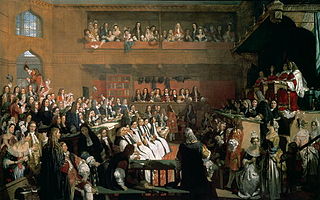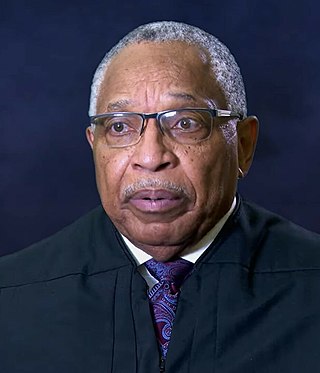Related Research Articles
In United States law, a reversible error is an error of sufficient gravity to warrant reversal of a judgment on appeal. It is an error by the trier of law (judge), or the trier of fact, or malfeasance by one of the trying attorneys, which results in an unfair trial. It is to be distinguished from harmless errors which do not rise to a level which brings the validity of the judgment into question and thus do not lead to a reversal upon appeal.

Jury nullification, also known in the United Kingdom as jury equity, or a perverse verdict, is when the jury in a criminal trial gives a verdict of not guilty even though they think a defendant has broken the law. The jury's reasons may include the belief that the law itself is unjust, that the prosecutor has misapplied the law in the defendant's case, that the punishment for breaking the law is too harsh, or general frustrations with the criminal justice system. Some juries have also refused to convict due to their own prejudices in favor of the defendant. Such verdicts are possible because a jury has an absolute right to return any verdict it chooses. Nullification is not an official part of criminal procedure, but is the logical consequence of two rules governing the systems in which it exists:
- Jurors cannot be punished for passing an incorrect verdict.
- In many jurisdictions, a defendant who is acquitted cannot be tried a second time for the same offense.
Hearsay is testimony from a witness under oath who is reciting an out-of-court statement that is being offered to prove the truth of the matter asserted. The Federal Rules of Evidence prohibit introducing hearsay statements during applicable federal court proceedings, unless one of nearly thirty exemptions or exceptions applies. The Federal Rules of Evidence define hearsay as:
A statement that: (1) the declarant does not make while testifying at the current trial or hearing; and (2) a party offers in evidence to prove the truth of the matter asserted in the statement..
In United States law, a motion is a procedural device to bring a limited, contested issue before a court for decision. It is a request to the judge to make a decision about the case. Motions may be made at any point in administrative, criminal or civil proceedings, although that right is regulated by court rules which vary from place to place. The party requesting the motion is the moving party or movant. The party opposing the motion is the nonmoving party or nonmovant.
William Brydges was a Canadian man whose arrest for murder resulted in the leading Supreme Court of Canada case R v Brydges on the right of a detainee to access duty counsel. His case was a Canadian precedent, and created significant controversy after the Supreme Court of Canada upheld his acquittal. He was found to have been denied access to an attorney because he was not informed of legal services available to him when he told police he could not afford a lawyer. This case had nationwide ramifications, requiring all police officers to advise a person under arrest of the availability of legal services even if they couldn't afford them.
The law of evidence, also known as the rules of evidence, encompasses the rules and legal principles that govern the proof of facts in a legal proceeding. These rules determine what evidence must or must not be considered by the trier of fact in reaching its decision. The trier of fact is a judge in bench trials, or the jury in any cases involving a jury. The law of evidence is also concerned with the quantum (amount), quality, and type of proof needed to prevail in litigation. The rules vary depending upon whether the venue is a criminal court, civil court, or family court, and they vary by jurisdiction.

Reggie Barnett Walton is a senior United States district judge of the United States District Court for the District of Columbia. He is a former presiding judge of the Foreign Intelligence Surveillance Court.

R v Lavallee, [1990] 1 S.C.R. 852 is a leading Supreme Court of Canada case on the legal recognition of battered woman syndrome. The judgment, written by Justice Bertha Wilson, is generally considered one of her most famous. The court held in favour of allowing battered woman syndrome to explain how the mental conditions for self-defence were present in this case, and Lavallee's acquittal was restored.

R v Mohan, 1994 CanLII 80, [1994] 2 SCR 9 is a leading Supreme Court of Canada decision on the use of expert witnesses in trial testimony.

Bigby v. Dretke 402 F.3d 551, the U.S. Court of Appeals for the Fifth Circuit heard a case appealed from the United States District Court for the Northern District of Texas on the issue of the instructions given to a jury in death penalty sentencing. The decision took into account the recent United States Supreme Court decisions concerning the relevance of mitigating evidence in sentencing, as in Penry v. Lynaugh.
The Barry Bonds perjury case was a case of alleged perjury regarding use of anabolic steroids by former San Francisco Giants outfielder and all-time Major League Baseball (MLB) career home run leader, Barry Bonds, and the related investigations surrounding these accusations. On April 13, 2011, Bonds was convicted of one felony count of obstruction of justice for giving an incomplete answer to a question in grand jury testimony. A mistrial was declared on the remaining three counts of perjury, and those charges were dropped. The obstruction of justice conviction was upheld by an appellate panel in 2013, but a larger panel of the appellate court exonerated him in 2015 by a 10-1 vote.
The Peggy Hettrick murder case concerns the unsolved 1987 death of Peggy Hettrick in Fort Collins, Colorado. Timothy Lee "Tim" Masters enlisted in the United States Navy following a high school career plagued by police accusation of murder when he was a sophomore at Fort Collins High School. After eight years in the Navy, he was honorably discharged. Masters worked for Learjet as an aviation mechanic until 1997, when he was arrested for the murder of Peggy Hettrick. He was charged and convicted of the Hettrick murder in 1999 and sentenced to life imprisonment without parole. His sentence was vacated in January 2008 when DNA evidence from the original crime scene indicated that he was not the responsible party. Three years after his release from prison, Masters was exonerated by the Colorado Attorney General on June 28, 2011. As of 2023, no one else has been charged with Hettrick's murder.
United States criminal procedure derives from several sources of law: the baseline protections of the United States Constitution; federal and state statutes; federal and state rules of criminal procedure ; and state and federal case law. Criminal procedures are distinct from civil procedures in the US.

R v W (D), [1991] 1 S.C.R. 742 is a leading decision of the Supreme Court of Canada on assessing guilt based on the credibility of witnesses in a criminal trial. More specifically, W.D. examines sexual assault cases and burdens of proof in evidence law.
In the United States, jury nullification occurs when a jury in a criminal case reaches a verdict contrary to the weight of evidence, sometimes because of a disagreement with the relevant law. It has its origins in colonial America under British law. The American jury draws its power of nullification from its right to render a general verdict in criminal trials, the inability of criminal courts to direct a verdict no matter how strong the evidence, the Fifth Amendment's Double Jeopardy Clause, which prohibits the appeal of an acquittal, and the fact that jurors cannot be punished for the verdict they return.

The Italian Code of Criminal Procedure contains the rules governing criminal procedure in every court in Italy. The Italian legal order adopted four codes since the Italian Unification. After the first two codes, in 1865 and 1913, the Fascist Government established in 1930 a new code adopting an inquisitorial system. In 1988 the Italian Republic adopted a new code, that could be considered to be somewhere in between the inquisitorial system and the adversarial system.

Her Majesty's Advocate v Thomas Sheridan and Gail Sheridan was the 2010 criminal prosecution of Tommy Sheridan, a former Member of the Scottish Parliament and his wife Gail Sheridan for perjury in relation to an earlier civil case called Sheridan v News Group Newspapers. Tommy Sheridan was found guilty and sentenced to three years in prison, whereas Gail was acquitted.
United States v. Dinitz, 424 U.S. 600 (1976), was a case in which the Supreme Court of the United States determined that the U.S. Const., Amend. V protection against double jeopardy did not prevent a retrial of a defendant, who had previously requested a mistrial.
People v. Newton, 8 Cal. App. 3d 359, was a controversial appeal arising from the voluntary manslaughter conviction of Huey P. Newton, the reputed co-founder of the Black Panther Party for Self Defense. The California Court of Appeal reversed Newton's conviction due to prejudicial error stemming from the trial court's failure to instruct the jury as to the possibility of involuntary unconsciousness as a complete defense to the charges. Though Newton's attorney arguably withdrew the defense at trial, the Court nonetheless held that the failure to instruct violated Newton's constitutional right to have the jury determine all material issues based on the evidence. This case stands for the proposition that trial courts have an affirmative duty to instruct juries as to a defense of involuntary unconsciousness where there exists evidence that may support that conclusion.
Hemphill v. New York, 595 U.S. ___ (2022), was a decision by the United States Supreme Court involving the application of Confrontation Clause of the Sixth Amendment to the United States Constitution. In its decision, the Court ruled on when a criminal defendant who opens the door to otherwise inadmissible evidence also opens the door to evidence that would otherwise be excluded by the Confrontation Clause.